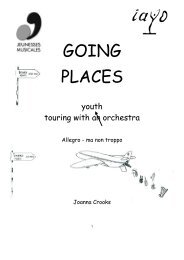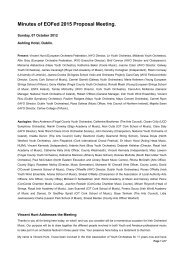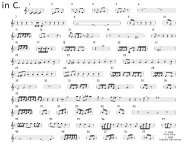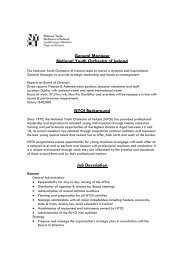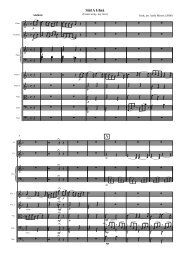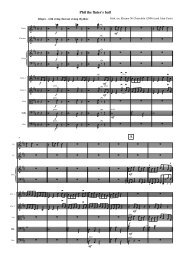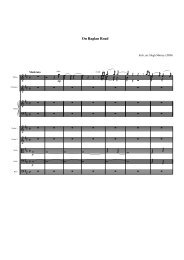A SOUND EAR II - Association of British Orchestras
A SOUND EAR II - Association of British Orchestras
A SOUND EAR II - Association of British Orchestras
Create successful ePaper yourself
Turn your PDF publications into a flip-book with our unique Google optimized e-Paper software.
A <strong>SOUND</strong> <strong>EAR</strong> <strong>II</strong><br />
Kill the acoustic<br />
No, not entirely. Expert use <strong>of</strong> well-designed acoustic insulation has been used to considerable success in pits and<br />
in rehearsal rooms (Royal Opera House, Birmingham Hippodrome, MOD). It has the effect <strong>of</strong> eliminating the ‘old’<br />
noise bouncing around, leaving the ‘fresh’ noise passing from instruments to players and audience. Noise levels can<br />
be dramatically lowered. Players find it easier because they can hear themselves and their neighbours. Conductors<br />
report much improved playing quality because they can distinguish instruments and more effectively modify the sound.<br />
Shield players from noisy neighbours using screens<br />
• Screens must be used with considerable care. They can provide useful reductions in both noise exposure and<br />
the experience <strong>of</strong> pain and shock. However, they can significantly increase the risks to the source player, and<br />
there have been instances where a screen has increased the exposure <strong>of</strong> the shielded player (because their own<br />
instrument reflects <strong>of</strong>f it).<br />
• Manufacturers have put a lot <strong>of</strong> effort into making manoeuvrable, non-reflectant screens, but orchestras continue<br />
to experience problems and some have stopped using them.<br />
• If a screen obstructs the sound <strong>of</strong> the source instrument, that player may be forced to play louder to deliver the<br />
same noise. Simultaneously, s/he may be affected by reflection from the screen, and the conductor may complain the<br />
sound is flat (because the screen takes <strong>of</strong>f high frequency noise which can make it sound as though the fundamental<br />
has dropped).<br />
• It is too easy for a screen to do more harm than good. Consider a situation where both players are exposed at 85dB,<br />
and a screen is introduced which delivers 3dB protection to the player in front, but forces the source player to play<br />
louder – increasing his/her exposure by 3dB. At first sight you may think the total risk is the same before and after,<br />
but decibels are logarithmic so one exposure has halved while another has doubled, and the total risk has increased.<br />
• Screen positioning must be carefully prescribed in the noise assessments.<br />
Use an appropriate space<br />
In educational projects, the acoustic <strong>of</strong> the room should be appropriate to the project.<br />
27<br />
Stay out <strong>of</strong> the line <strong>of</strong> fire<br />
• In educational projects, players should position themselves out <strong>of</strong> the line <strong>of</strong> fire <strong>of</strong> directional instruments.<br />
• Do not let (for example) soprano soloists face the orchestra<br />
Photo - Chris Stock Photography



